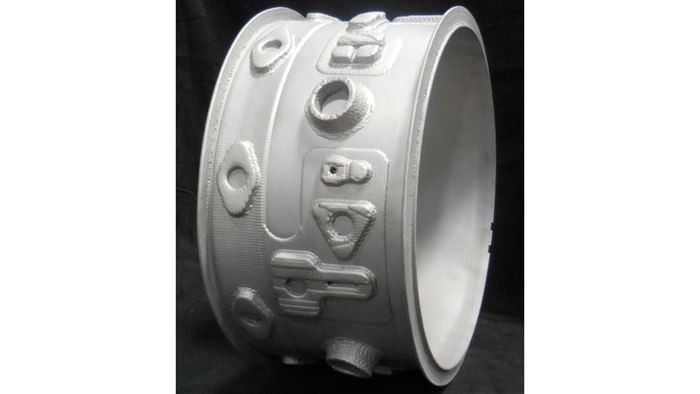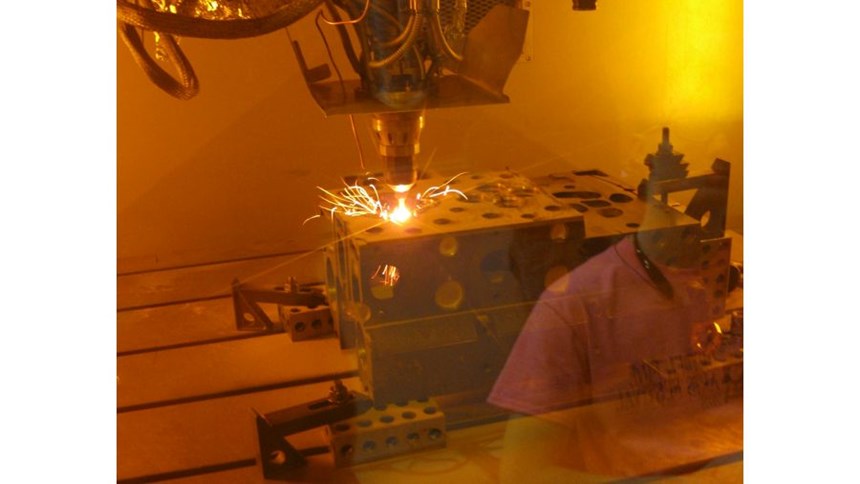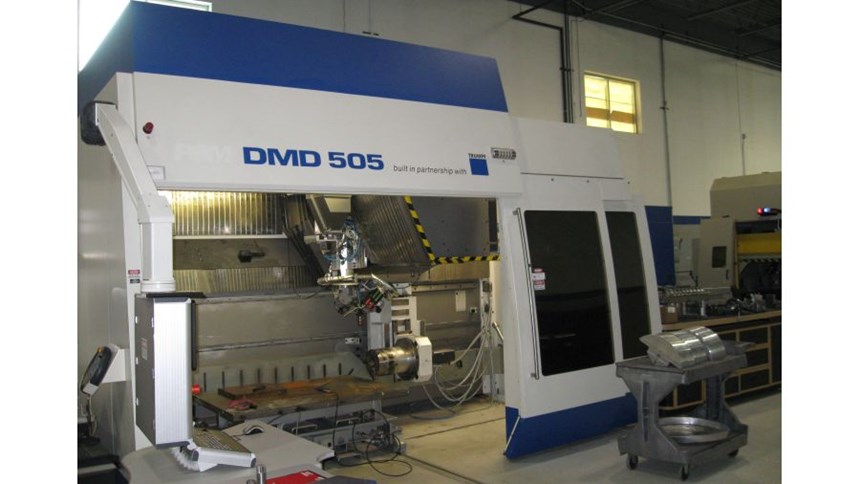Efficiency in AM: Just the Details?
Rather than growing the entire part, the most effective use of additive manufacturing in many cases might be to grow the features onto a pre-existing blank.
Part of what makes 3D printing fascinating is the seemingly magical way it produces a part. Starting as if from nothing—that is, starting with an empty machine or an undifferentiated bed of powder—the 3D printer or additive manufacturing machine proceeds without tooling and without a pattern to produce a solid and precisely detailed part. But this apparently magical effect is also, in many cases, inefficient.
DM3D, an Auburn Hills, Michigan, maker of additive-manufactured production metal parts, has recently been making the case to some customers that there is a better way to additively build. Rather than starting from nothing, this company has found cases in which the better choice is to begin with a partially completed workpiece.
A 25-inch diameter Inconel 625 component representing a jet engine casing illustrates this concept. This part, which is shown in the photo, is a demonstration piece. However, a prospective customer is evaluating a production application involving a related component. Such a part today could be produced subtractively, with the entire part machined from a forged blank. The expense would be considerable. Alternately, the part could be grown entirely through an additive process, but then it is the cycle time that becomes considerable. For a part like the test piece shown, the time to grow it entirely through AM would be something like 500 hours.
But the option the photo illustrates is different from both of these choices. Beginning with a cylindrical blank of material produced through forging or roll forming, additive manufacturing could be used to add just the part’s detailed features. When DM3D made the part this way, the additive cycle time was only 21 hours.
As additive part-making processes move from prototyping into production, our thinking about how to apply them has to adapt. For a prototype, the possibility of creating the part in a single operation starting from nothing holds great appeal. But in production, we might find that the successes of additive more often resemble the engine casing part. That is: Additive used in combination with a pre-existing workpiece, so that additive is used only to add detail, only where additive makes sense.
“TransFormAM” is DM3D’s brand name for this idea of transforming preforms into finished parts. Bhaskar Dutta, Ph.D., is the company’s chief operating officer. He says the appeal of this idea extends well beyond the time savings. Selectively building additive features onto traditionally manufactured blanks actually addresses various concerns impeding the advance of AM, just one of which is the amount of risk built into the part as layers of material are added.
Material Deposition
DM3D makes parts using its own proprietary system for direct metal deposition. Metal powder is fed into a pool melted by a laser to build 3D structures. Compared to metal additive manufacturing systems that build parts using a stationary powder bed, this material-fed process permits larger parts and faster builds. DM3D’s patents on its own deposition technology relate to in-situ optical measurement of the melt pool in order to control geometry, as well as precisely controlled blending of powder from separate hoppers to create custom combinations of materials. The company’s primary business is making parts for customers in its own facility, but it also installs AM systems for customers wishing to employ the same technology in their facilities.
On typical metal additive manufacturing systems (again, powder-bed systems), the maximum part size often is not much more than 1 cubic foot. DM3D’s machines operate on a different scale than this. They layer material in thicknesses ranging from 0.02 to 0.06 inch, producing features that are coarse compared to the details a powder bed machine can produce. But because the material supply travels with the laser, it can range as far as the travels of the machine. At DM3D, the largest machine company has put into use features a work envelope measuring 2,000 × 1,060 × 750 mm. Thus, the machine could produce a part that big, but perhaps more significantly, it could also be used to grow features onto any workpiece nearly as large as this that could be wheeled inside of that envelope.
Hours of Risk
Dutta says the problem with long cycle time for an additive build is not just the delay it imposes. If that were the case, then a 500-hour build might be acceptable. That span of time, given that it occurs in a continuous run, might be competitive with the lead time to wait for an Inconel forging and have that forging proceed through the necessary machining steps. (The additive part would need machining, too, but not nearly as much.)
The larger problem, he says, is the concentration of so much value creation into this one long cycle—a cycle with many sources of potential inconsistency, including not just the motions of the machine but also the operation of the laser, its thermodynamic effects, the powder flow and the quality of the powder itself. Any one of these factors might produce an error leading to an unacceptable part, and that error might not be discovered until the entire cycle has run. “The 500-hour cycle means 499 hours of risk,” he says.
For high-value parts, he says a more acceptable process would safeguard that value with shorter steps that can be validated in sequence. Manufacturing a blank first, then growing additive features onto that blank, satisfies this requirement.
That approach also overcomes other, equally serious objections to additive. One of these is cost. The cost of an operation such as roll forming is less than that of a large-scale additive process such as direct metal deposition. Reserving additive only for details therefore is more economical.
Another obstacle additive faces relates to material properties. Critical metal components typically require a wrought microstructure, meaning the material structure and properties delivered through forging. If the hypothetical 500-hour engine casing was produced for a real aircraft, then that part would not see flight anytime soon, because the part made this way would not feature that microstructure. It would not fly until testing could demonstrate that its properties are just as good. But the casing made by adding features to a blank could begin with—and would mostly consist of—a forged part.
The Other Hybrid
How to refer to this concept is just one of the questions the company has been working through in order to advance the idea. For a while, “hybrid manufacturing” seemed like the logical and natural term, but then that term more popularly came to be associated with machine tools that combine both additive and subtractive processing. There is no conflict, because a hybrid machine of this type could be used to create a TransFormAM style of part. Still, the concept needed its own distinct label.
It needs that name because the idea will advance, Dutta says. That much seems clear. Building additive features onto pre-existing workpieces allows additive to be deployed more cost effectively, and also used more readily in applications where material properties are a concern. The material added to the part could even be different than that of the underlying workpiece, he says. The advance of AM will ultimately lead to the point where additive joins other processes as an accepted option for making production parts, he says, and in many cases, AM will be used in harmony with those other processes in the creation of a single workpiece.
Read Next
Crushable Lattices: The Lightweight Structures That Will Protect an Interplanetary Payload
NASA uses laser powder bed fusion plus chemical etching to create the lattice forms engineered to keep Mars rocks safe during a crash landing on Earth.
Read MoreBike Manufacturer Uses Additive Manufacturing to Create Lighter, More Complex, Customized Parts
Titanium bike frame manufacturer Hanglun Technology mixes precision casting with 3D printing to create bikes that offer increased speed and reduced turbulence during long-distance rides, offering a smoother, faster and more efficient cycling experience.
Read More3D Printed Polymer EOAT Increases Safety of Cobots
Contract manufacturer Anubis 3D applies polymer 3D printing processes to manufacture cobot tooling that is lightweight, smooth and safer for human interaction.
Read More




















